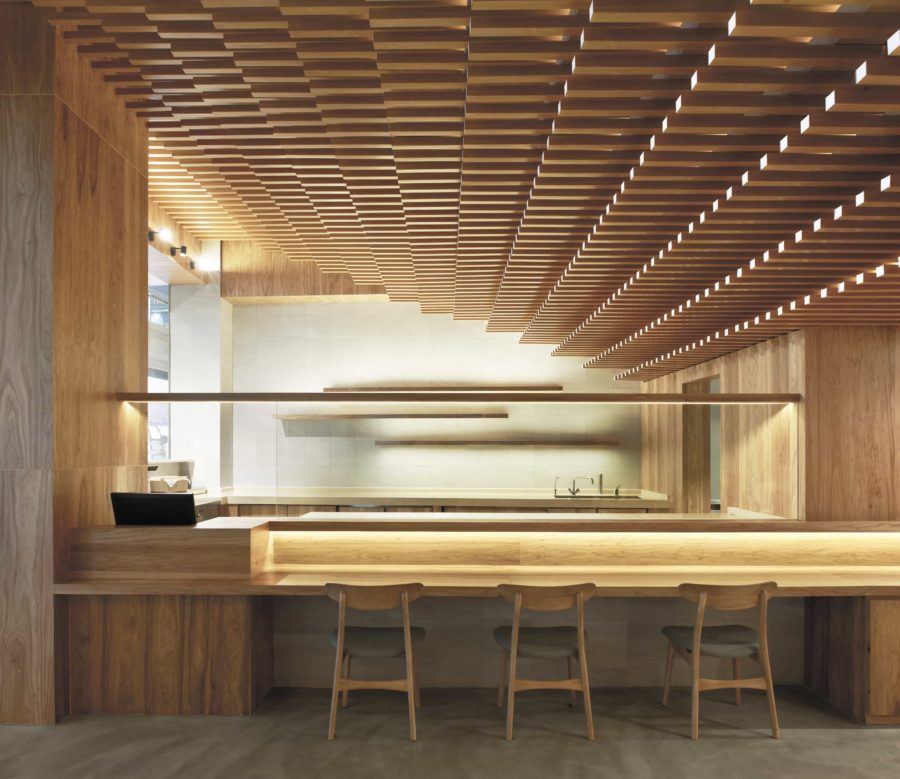浜松市天竜区に建つセカンドハウスの計画。計画地は都市計画区域外で、起伏の大きな山に周囲を囲まれ、敷地内を渓流が流れる、自然豊かな環境である。敷地内には、梅の木やサルスベリやモミジといった印象的な木々が立ち並ぶ。
建主は、週末をここで過ごし、将来的にはここへ移り住んで農業を営もうと考え購入を決意した。要望は、既存の母屋の軽微な改修と崖沿いに数棟建っていた小屋の解体、そして新たな小屋(農業用倉庫)の新築であった。打ち合わせや現場調査に足を運ぶと、草抜きをしたり石を集めたり、冬には焚火をしたり、夏には川に入ったりする建主の生活が印象的であった。そんな生活にあった小屋のあり方を考えた。
新築の小屋の配置は道路面に沿わせることとした。既存小屋群の位置は急峻な崖沿いとなっているため難しく、また、畑としてなるべくまとまった面積を平場に確保する必要があったからである。道路面には多種多様な木々が立ち並んでおり、それらをかわすような平面の形と屋根の高さを検討した。柱は木の根っこをなるべく傷めないよう独立基礎の柱脚で計画し、梁は木の枝張りをかわすような高さで繋いでいった。垂木は柱梁のフレームから大きく跳ね出し、ルーバー状に連続させた。屋根が高木の下をくぐったり、低木を抱え込んだりしながら、山並みと呼応してふわりと浮かび、木々の中に溶け込んでいく。
屋根下空間は、壁で仕切り5種類の空間を並べた。建物へのアプローチ、農機具置き場、木陰の縁側ベンチ、作業スペース、天日干しスペースである。屋根の下を歩くと、5種類の空間の裏側と表側を行き来するような構成である。屋根の高低は、木々をかわすだけでなく空間の使い方によっても決まっている。たとえば、アプローチは人を迎え入れるよう反り上がり、作業スペースは屋根を高くして大きな空間を確保し、機具置き場は人の手が届くようなサイズとしている。2次部材の多くは解体した小屋の廃材を再利用し、新築でありながらも風景に馴染むようにと考えた。これらは建主と設計事務所によるDIY施工であり、部材の足し引きが簡単にできるような未来の使われ方に開かれた躯体のつくりである。
建主の生活が、その生活を育むための建築が、自然に溶け込む。そんな風景を思い描きながら計画した。建築がダイレクトに自然との関係をもつこと、それは山のような大きな風景の中での佇まいであり、1本1本の木々がつくり出す空間でもある。ここに建築を建てることが、美しい里山や庭の木々の存在を肯定することとなった。(葛島隆之)
Pergola as agricultural warehouse that responds to existing trees and lifestyles
This is a plan for a second house to be built in Tenryu-ku, Hamamatsu City. The planned site is outside the urban planning area and is surrounded by rolling mountains and a mountain stream running through the site, making it a rich natural environment. In addition, the site is lined with impressive trees such as Japanese apricot trees, Lagerstroemia indica, and maple trees.
The owner decided to purchase the property to spend weekends here and move here to farm in the future. They wanted to make minor improvements to the existing main house, demolish several sheds along the cliff, and build a new shed (agricultural warehouse). When we visited the site for meetings and site surveys, we were impressed by the owner’s lifestyle of pulling weeds, collecting stones, making bonfires in the winter, and bathing in the river in the summer. So we thought about how the hut should fit such a lifestyle.
The new huts were placed along the road surface. The location of the existing huts was difficult because they are located along a steep cliff, and it was also necessary to secure as large an area as possible as a field on a flat site. The road was lined with various trees, and we considered the shape of the flat surface and the height of the roof to avoid the trees. To avoid damaging the roots of the trees as much as possible, the columns were planned with independent foundation legs, and the beams were connected at a height that would avoid overhanging the branches of the trees. The rafters are louvered continuously, springing out from the post-and-beam framing. The roof floats softly in response to the mountain range and blends in with the trees as it passes under the tall trees and embraces the shrubs.
The under-roof space is divided by walls and lined with five different spaces. These are the approach to the building, a place to store farm equipment, a shaded bench on the edge, a workspace, and a space to dry out in the sun. Walking under the roof, the visitor moves between the back and front sides of the five different spaces. The height of the roof is determined not only by dodging trees but also by the use of space. For example, the approach is raised to welcome people, the roof is raised to provide a large space for work, and the equipment storage area is sized to allow people to reach it. Many of the secondary materials were reused from the dismantled shed and were intended to fit in with the landscape even though it is a new building. The building was constructed as a DIY project by the owner and the design office, and the structure is open to future use so that components can be easily added or subtracted from each other.
The architecture for nurturing the client’s lifestyle blends in naturally. We planned this project while envisioning such a landscape. The architecture has a direct relationship with nature, both in its appearance in a large landscape like a mountain and in the space created by each tree. Building the architecture here was an affirmation of the existence of the beautiful satoyama and the trees in the garden. (Takayuki Kuzushima)
【Pergola】
所在地:静岡県浜松市天竜区
用途:倉庫、住宅
クライアント:個人
竣工:2021年
設計:葛島隆之建築設計事務所
担当:葛島隆之
施工:分離発注
撮影:葛島隆之建築設計事務所、金川晋吾
工事種別:新築(一部、住宅リノベーション)
構造:鉄骨造
規模:平屋
敷地面積:2450.73m²
建築面積:23.24m²
延床面積:9.81m²
設計期間:2019.12-2020.12
施工期間:2021.01-2021.08
【Pergola】
Location: Tenryu-ku, Hamamatsu-shi, Shizuoka, Japan
Principal use: Warehouse, Residential
Client: Individual
Completion: 2021
Architects: Takayuki Kuzushima and Associates
Design team: Takayuki Kuzushima
Contractor: Separate order
Photographs: Takayuki Kuzushima and Associates, Shingo Kanagawa
Construction type: New Building, partly Renovation
Main structure: Steel
Building scale: 1 story
Site area: 2450.73m²
Building area: 23.24m²
Total floor area: 9.81m²
Design term: 2019.12-2020.12
Construction term: 2021.01-2021.08








